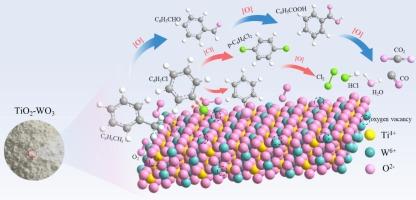Construction of TiO2-WO3 solid acid catalysts and performance study on catalytic degradation of chlorobenzene and methylbenzene mixture
IF 4.6
3区 材料科学
Q2 MATERIALS SCIENCE, MULTIDISCIPLINARY
引用次数: 0
Abstract
The novel TiO2-WO3 solid acid catalyst system was successfully constructed through modified sol-gel method, by using different molar ratios of Ti/W and various chelating agents. The catalytic degradation performance of these catalysts were researched for the mixture [500 ppmv chlorobenzene (CB) and 500 ppmv methylbenzene (MB)]. The results showed that the specific surface area, pore structure, crystal size, acid properties and redox properties of TiO2-WO3 solid acid catalysts were effectively improved by reasonable selection and optimization of Ti/W molar ratio and chelating agent. The TiO2-WO3 composite catalysts displayed good catalytic activity and selectivity in the catalytic degradation of both CB and MB. Among them, the catalyst with the Ti/W molar ratio of 4/1 (4Ti1W) demonstrated the optimal catalytic activity, with the T90% for CB and MB degradation being 355 °C and 320 °C, respectively. Among the types of chelating agents, the TiWO-CA catalyst with citric acid as the chelating agent was the best since it had high acidic sites and good redox ability. In addition, the stability of TiWO-CA in continuous reaction was proved by 60 h tolerance test. This study offers a theoretical basis and experimental insights for the subsequent development of highly active and green solid acid samples for VOCs treatment.

TiO2-WO3固体酸催化剂的构建及催化降解氯苯和甲苯混合物的性能研究
采用溶胶-凝胶法,采用不同的Ti/W摩尔比和不同的螯合剂,成功构建了新型TiO2-WO3固体酸催化剂体系。研究了这些催化剂对500 ppmv氯苯(CB)和500 ppmv甲苯(MB)混合物的催化降解性能。结果表明,通过合理选择和优化Ti/W摩尔比和螯合剂,可以有效地改善TiO2-WO3固体酸催化剂的比表面积、孔结构、晶粒尺寸、酸性能和氧化还原性能。TiO2-WO3复合催化剂对CB和MB的催化降解均表现出良好的催化活性和选择性,其中Ti/W摩尔比为4/1 (4Ti1W)的催化剂表现出最佳的催化活性,对CB和MB的降解T90%分别为355℃和320℃。在各种螯合剂中,以柠檬酸为螯合剂的TiWO-CA催化剂具有较高的酸性位点和良好的氧化还原能力,效果最好。另外,通过60 h耐受性试验证明了TiWO-CA在连续反应中的稳定性。本研究为后续开发高效、绿色的固体酸处理VOCs样品提供了理论基础和实验见解。
本文章由计算机程序翻译,如有差异,请以英文原文为准。
求助全文
约1分钟内获得全文
求助全文
来源期刊

Materials Science and Engineering: B
工程技术-材料科学:综合
CiteScore
5.60
自引率
2.80%
发文量
481
审稿时长
3.5 months
期刊介绍:
The journal provides an international medium for the publication of theoretical and experimental studies and reviews related to the electronic, electrochemical, ionic, magnetic, optical, and biosensing properties of solid state materials in bulk, thin film and particulate forms. Papers dealing with synthesis, processing, characterization, structure, physical properties and computational aspects of nano-crystalline, crystalline, amorphous and glassy forms of ceramics, semiconductors, layered insertion compounds, low-dimensional compounds and systems, fast-ion conductors, polymers and dielectrics are viewed as suitable for publication. Articles focused on nano-structured aspects of these advanced solid-state materials will also be considered suitable.
 求助内容:
求助内容: 应助结果提醒方式:
应助结果提醒方式:


